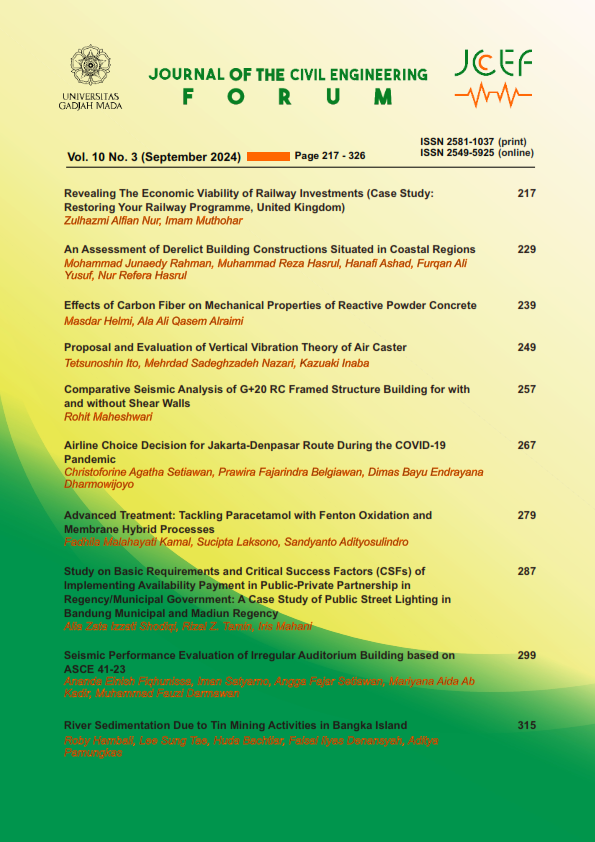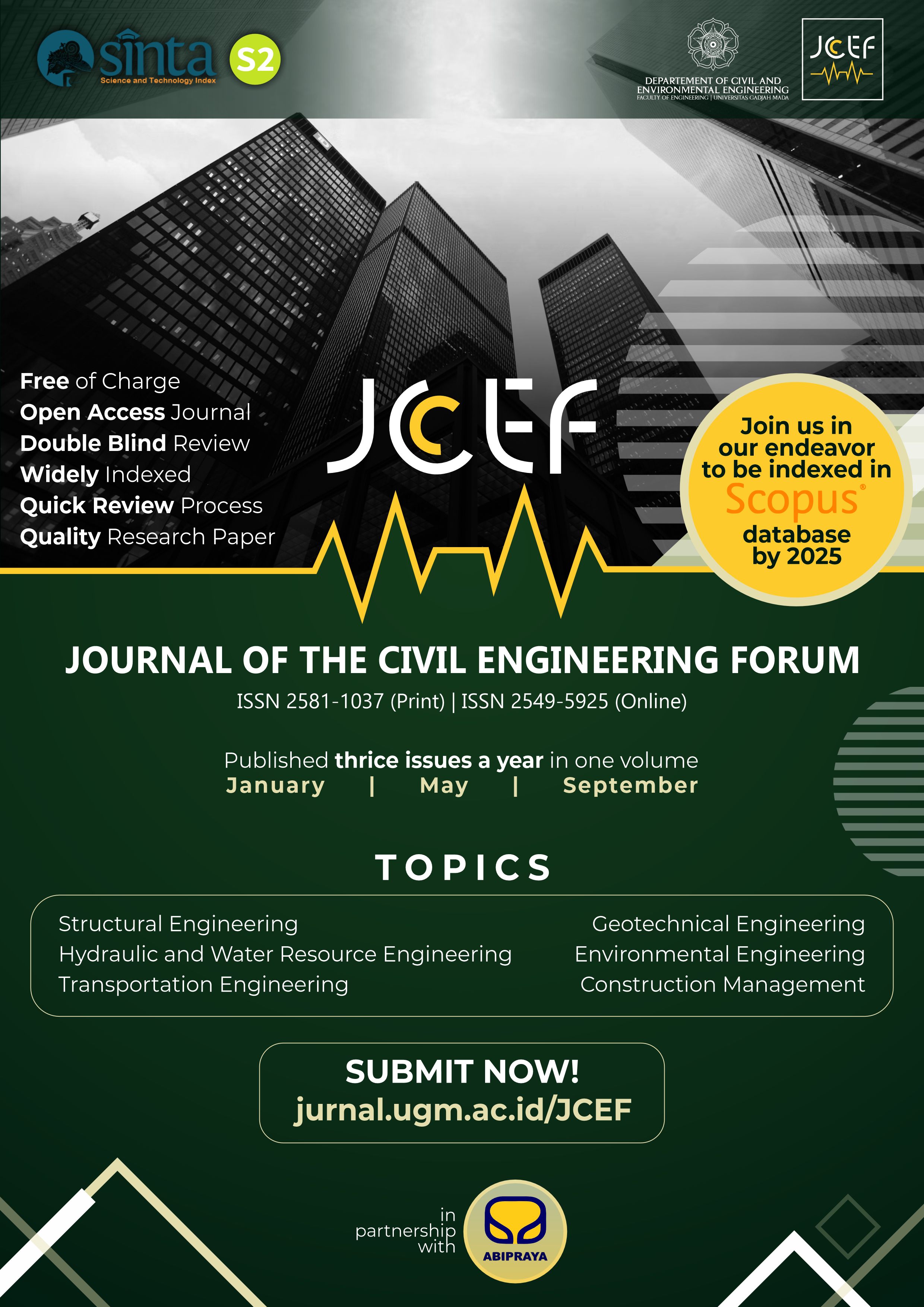Effects of Carbon Fiber on Mechanical Properties of Reactive Powder Concrete
Abstract
The use of fiber generally might change the mechanical properties of concrete in flexural or compressive strength. Reactive powder concrete (RPC) is one of the ultra-high-performance concrete types that has been applied for some constructions. Carbon fiber, having high strength in tensile, also has the potency to improve the physical characteristics of RPC. The purpose of this study is to evaluate the flexural and compressive performance of RPC, focusing on the interfacial binding of carbon fiber. Flexural and compressive tests used samples with dimensions of 40 x 40 x 160 mm were tested in accordance with BS-EN-196-1:2011, which allows to use one of the two broken pieces from the flexural test as the sample. The microstructure surrounding carbon fiber and paste was qualitatively compared using Scanning Electron Microscopy (SEM) in the secondary electron detector mode. Samples were subjected to static pressure at 8 MPa after 1 hour of pouring and heat curing at 240 °C in a dry oven after demolding. Results show that the presence of carbon fiber increased the flexural strength of RPC by up to 28.85% for samples without treatments and up to 14.32% for samples with both treatments. Although carbon fiber increased toughness by 20% and flexural modulus by 6%, it had no effect on the failure mode after reaching the peak load, which remained brittle. On the other hand, the presence of carbon fiber had little effect on compressive strength. Despite the pressure and heat, curing treatments had no effect on enhancing the adhesion between carbon fiber and cement paste, which was indicated by the
undamaged surface of carbon fiber. However, the implementation of both treatments on samples might produce RPC with good mechanical properties in flexure.
References
A., R., Putra, J. W. and Saputra, J. (2022), ‘Chemical anchor pullout force modeling with variation of anchor embedment length in concrete and concrete strength’, Journal of the Civil Engineering Forum 8(3), 277–290. URL: https://doi.org/10.22146/jcef.3769
Ahmed Ali, M., Elthakeb, A., Mohamed, U. and Taha Noaman, M. (2021), ‘Behavior of reactive powder concrete beams exposed to fire’, Diyala Journal of Engineering Sciences 14(4), 1–10. URL: https://doi.org/10.24237/djes.2021.14401
Al-Hassani, H. M., Khalil, W. I. and Danha, L. S. (2014), ‘Mechanical properties of reactive powder concrete with different steel fiber and silica fume contents’, ATC Bulletin of Engineering Tome VII, 48–58. URL: https://doi.org/10.30684/etj.31.16A.8
Alwash, J. J. and Al-Sultan, S. M. B. (2018),‘Flexural behavior of reactive powder concrete beams with various types of fibers’,International Journal of Civil Engineering and Technology 9(4), 32–44.
Bahedh, M. A. D. R. and Jaafar, M. S. (2018),‘Ultra high-performance concrete utilizing fly ash as a cement replacement under autoclaving technique’, Case Studies in Construction Materials 9. URL: https://doi.org/10.1016/j.cscm.2018.e00202
Chen, X. and Liu, J. (2004),‘Residual strength of hybridfiber-reinforced high-strength concrete after exposure to high temperatures’, Cement and Concrete Research 34(6), 1065–1069. URL: https://doi.org/10.1016/j.cemconres.2003.11.010
Cwirzen, T. (2007), ‘The impact of the heat-treatment process on the characteristics of reactive powder concrete’, Advance Cement Research 19(1), 25–33. URL: https://doi.org/10.1680/adcr.2007.19.1.25
Fawzi, N. M.,Aljalawi, N.,Waisi, B., Hassan,A. A.,Waisi, B. I., Saeed, S. S. and Megbel, S. M. (2021), ‘Effect of nanomaterial on properties of reinforced reactive powder concrete by carbon fiber’, Turkish Journal of Physiotherapy and Rehabilitation 32(3).
Ghosni, N., Samali, B. and Vessalas, K. (2013), Energy absorption and flexural toughness evaluation of fiberreinforced polymer modified concrete, in ‘Proceeding of VIII International Conference on Fracture Mechanics of Concrete and Concrete Structures FraMCoS- 8 (Van Mier et al Eds)’, Toledo, Spain.
Hannant, D. (1998), Fibre-reinforced cements and concretes, in J. llston, ed., ‘Construction Materials-Their Nature and Behavior’, E & FN Spon, London.
Helmi, M., Hall, M. R. and Rigby, S. P. (2018), ‘Effect of pressure and heat treatments on the compressive strength of reactive powder concrete’, MATEC Web of Conferences 147, 01006. URL: https://doi.org/10.1051/matecconf/201814701006
Horners, S. (2008), Activity 20 - Bendy Wafer, Pearson Education, Essex, United Kingdom.
Janus, G. and Grzeszczyk, S. (2020), ‘Reactive powder concrete with blastfurnace slag cement’, Cement, Wapno, Beton 2020(4), 306–315. URL: https://doi.org/10.32047/cwb.2020.25.4.5
Johnston, C. D. (2006), Fiber-Reinforced Cements and Concretes, Taylor & Francis, New York.
Kadhum, M. M. (2015), ‘Studying some mechanical properties of reactive powder concrete using local materials’, Journal of Engineering 21(7), 113–135. URL: https://doi.org/10.31026/j.eng.2015.07.09
Katz, J., Li, V. C. and Kazmer, A. (1995), ‘Bond properties of carbon fibers in a cementitious matrix’, Journal of Materials in Civil Engineering 7(2), 125–128. URL: https://doi.org/10.1061/(ASCE)0899-1561(1995)7:2(125)
Kinayekar, S. M., Gundakalle, V. D. and Kulkarni, K. (2014), ‘The effect of the addition of carbon fibers on the mechanical properties of high-strength concrete’, International Journal of Innovative Research in Science, Engineering, and Technology 3(1), 8777–8784.
Mahmoud Hama, S., Hamdullah, D. N. and Hama, S. M. (2021), ‘Reactive powder concrete beam’s behavior in flexural: Review’, Diyala Journal of Engineering Sciences 14(4), 113–131. URL: https://doi.org/10.24237/djes.2021.14410
Nambiar, E. and Ramamurthy, K. (2008), ‘Models for strength prediction of foam concrete’, Materials and structures 41(2), 247–254. URL: https://doi.org/10.1617/s11527-007-9234-0
Neville, M. (2018), Properties of concrete, 5th edn, Pearson Education Limited.
Pradere, P. and Sauder, C. (2008), ‘Transverse and longitudinal coefficient of thermal expansion of carbon fibers at high temperatures (300- 2500 k)’, Carbon 46(14), 1874–1884. URL: https://doi.org/10.1016/j.carbon.2008.07.035
Raheem, H. A., Mahdy, M. and Mashaly, A. A. (2018), ‘Mechanical and fracture mechanics properties of ultra-high-performance concrete’, IOSR Journal of Mechanical and Civil Engineering (IOSR-JMCE) 15(5), 33–39. URL: https://doi.org/10.1016/j.conbuildmat.2019.03.298
Richard, P. and Cheyrezy, M. (1995),‘Composition of reactive powder concrete’, Cement and Concrete Research 25(7), 1501–1511. URL: https://doi.org/10.1016/0008-8846(95)00144-2
Saloma, H. and Agistin, V. (2019), ‘Analysis of mechanical properties of reactive powder concrete with curing temperature variation’, IOP Conf. Series: Materials Science and Engineering 620, 012045. URL: https://doi.org/10.1088/1757-899X/620/1/012045
Sanjuán, M. A. and Andrade, C. (2021),‘Reactive powder concrete: Durability and applications’,Applied Sciences (Switzerland) 11(12). URL: https://doi.org/10.3390/app11125629
Shi, R. J., Xiang, Z., Liu, S. G., Wang, D. H. and Ju, Y. Z. (2019), ‘Mechanical properties of reactive powder concrete: A review’, IOP Conference Series: Materials Science and Engineering 629(1). URL: https://doi.org/10.1088/1757-899X/629/1/012009
Szoke, S. (2006), Resistance to fire and high temperatures, in J. Lamond and J. Pielert, eds, ‘Significance of Tests and Properties of Concrete and Concrete-Making Materials’, ASTM International, West Conshohocken, PA.
Tam, C. M. and Tam, V. W. Y. (2012), ‘Microstructural behavior of reactive powder concrete under different heating regimes’. URL: https://doi.org/10.1680/macr.2012.64.3.259
Wang, J. Y., Chia, K. S., Liew, J. Y. R. and Zhang, M. H. (2013), ‘Flexural performance of fiber-reinforced ultralightweight cement composites with low fiber content’, Cement and Concrete Composites 43, 39–47. URL: https://doi.org/10.1016/j.cemconcomp.2013.06.006
Yazıcı, H. (2018), ‘Prediction of the strength properties of carbon fiber-reinforced lightweight concrete exposed to high temperature using artificial neural network and support vector machine’,Advances in Civil Engineering 2018, Article ID 5140610.
Yazıcı, H., Yiğiter, H., Karabulut, A. S. and Baradan, B. (2008), ‘Use of fly ash and ground granulated blast furnace slag as an alternative silica source in reactive powder concrete’, Fuel 87(12), 2401–2407.
Zhang, X., Ge, L., Zhang, Y. and Wang, J. (2019), ‘Mechanical properties of carbon fiber rpc and design method of carbon fiber content under different curing systems’, Materials 12, 3759.
Ženíšek, M., Vlach, T. and Laiblová, L. (2016), ‘Flexural strength of reactive powder concrete’, Solid State Phenomena 249, 108–111.
Copyright (c) 2024 The Author(s)

This work is licensed under a Creative Commons Attribution-ShareAlike 4.0 International License.
Copyright is granted to authors for the purpose of providing protection for articles written to describe experiments and their results. JCEF will protect and defend the work and reputation of the author and are also willing to address any allegations of violation, plagiarism, fraud, etc. against articles written and published by JCEF. JCEF is published under the terms of the Creative Commons Attribution-ShareAlike 4.0 International License (CC BY-SA 4.0). The author holds the copyright and assigns the journal rights to the first publication (online and print) of the work simultaneously.




